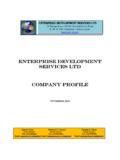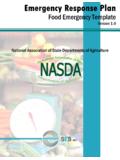Transcription of MICHIGAN DEPARTMENT OF AGRICULTURE FOOD
1 MDARD Labeling (REV 5/2015). MICHIGAN DEPARTMENT OF AGRICULTURE & rural development . FOOD & DAIRY DIVISION. FOOD LABELING GUIDE. For Products Manufactured or Sold in MICHIGAN The Food and Dairy Division of the MICHIGAN DEPARTMENT of AGRICULTURE and rural development (MDARD) is responsible for assuring that food and other consumer packages are properly labeled. The MICHIGAN Food Law of 2000, PA 92 of 2000, as amended, and Title 21 of the Code of Federal Regulations (21 CFR) are the primary MICHIGAN laws governing food labeling. This guide summarized general labeling requirements for food products. In a document such as this, it is impractical to attempt to answer every food labeling question that may arise.
2 To help minimize regulatory action and delays, it is recommended that manufacturers and distributors become fully informed about the applicable labeling laws before offering food for distribution in MICHIGAN . FDA General Labeling Web Site: There are two ways to label packages and containers: a. Place all required label statements on the front label panel (the principal display panel or PDP), or, b. Place certain specified label statements on the principal display panel and other labeling on the information panel (the label panel immediately to the right of the principal display panel, as seen by the consumer facing the product). 1. MDARD Labeling (REV 5/2015). DEFINITIONS. The PRINCIPAL DISPLAY PANEL (PDP) is the portion of the package that is most likely to be seen by the consumer at the time of purchase.
3 The product identity and the declaration of quantity must appear on the PDP. All other required information may be placed either on the PDP or the information panel. The INFORMATION PANEL is generally the label panel immediately to the right of the PDP, as seen by the consumer facing the product (a few exceptions exist for irregular-size packages refer to 21 CFR ). SUMMARY OF THE BASIC REQUIREMENTS: 1. THE STATEMENT OF IDENTITY: The name of the food must be the common or usual name of the food, if it has one. It would be misleading to label a food with a new name when that food has an established name. If no common or usual name exists, then an appropriately descriptive phrase must be used; the phrase must accurately describe the basic nature of the food or its characterizing ingredients or properties.
4 If the food is subject to a standard of identity, it must bear the name specified in the standard. The statement of identity must appear on the principal display panel in lines generally parallel to the base of the package. It must be prominent and of a type size reasonably related to the most prominent printed matter on the front panel; generally, this means at least one-half the size of the largest print on the label. a. ARTIFICIALLY FLAVORED: When artificial flavorings are used that simulate, resemble, or reinforce the characterizing flavor of the food, the product name must be accompanied by the phrase artificially flavored or artificial in type not less than one-half the size of the name of the food; for example, Artificial Orange Flavored Punch or Artificially Flavored Strawberry Cheesecake (21 CFR ).
5 B. ARTIFICIALLY SWEETENED: Beverages that contain artificial sweeteners shall be identified as artificially sweetened in letters not less than one-half the height of the other words in the product identify (21 CFR ). c. FANCIFUL TERMS: Fanciful terms are not encouraged since they are often confusing to the consumer. However, they may be used as a supplement to a proper statement of identity and are in no way false or misleading. For example, a label may read Belly Bomber Ham & Cheese Sandwich (but not Belly Bomber by itself). d. FORM OF THE FOOD: Where a food is marketed in several forms (sliced, diced, whole, dried, etc.), the particular form must be part of the identity statement (21 CFR (c)).
6 E. IMITATION: A food that is an imitation of another food must be labeled, in type of uniform size and prominence, with the word imitation immediately followed by the name of the food imitated (MCLA (g)(iii)). Any product that resembles and substitutes for a traditional food and contains less nutritional value than the traditional food is considered an imitation (21 CFR. (e)(1)). 2. NAME AND ADDRESS OF A RESPONSIBLE PARTY: Must be declared as a unit and not separated by other label information. The address must include street address, city, state, and zip code. However, if the street address is listed in a current city or telephone directory under the responsible party name, then street address may be omitted on the label.
7 If the responsible party is other than the manufacturer, the name must be qualified by a term describing the relationship to the product : Distributed by____ . (21 CFR ). 3. QUANTITY DECLARATION: Must be placed on the principal display panel (PDP) in the lower third of the panel. It must be printed in the required minimum type size and surrounded by sufficient clear space. The print size of the statement is regulated by the area of the PDP and is based on the size of a lower case o. If only upper case letters are used, the size is based on the height of the upper case letters. 2. MDARD Labeling (REV 5/2015). Minimum Type Size of Net Quantity Area of Principal Display Panel Statement < 5 square inches 1/16 inch > 5 square inches < 25 square inches 1/8 inch > 25 square inches < 100 square inches 3/16 inch > 100 square inches < 400 square inches 1/4 inch > 400 square inches 1/2 inch (21 CFR ).
8 METRIC DECLARATION: Both metric and inch/pound measures must be declared in the net quantity statement. Either may be primary, for example, Net wt 1 lb (453 g) or Net wt 453 g (1 lb). This requirement for the net quantity statement to include metric units does not apply to foods packaged at the retail store level or for random weight packages. (Fair Packaging & Labeling Act). 4. INGREDIENT LIST: A food product made from more than one ingredient must bear a complete list of ingredients in order of descending predominance by weight (21 CFR ). Ingredients must be listed by their common or usual name. Spices and flavorings may be declared by the generic term, spices or flavorings (artificial flavorings must be identified as artificial).
9 The source of all fats and oils must be specified ( , soybean oil rather than vegetable oil; lard rather than shortening). Preservatives must have their function declared ( , preserved with sulfur dioxide ). a. STANDARDS OF IDENTITY: Specify in detail what can and cannot be sold under a certain product name. To a great extent, a standard of identity is a recipe for a food established by law, but it also prescribes ingredient labeling requirements and identification (naming) requirements. Examples of foods with standards of identities include bread, jams, jellies, preserves, cocoa, chocolate, and macaroni. Obtain specific federal standards of identify from the Superintendent of Documents (see page 5).
10 B. COLORINGS: All certified colors must be listed in the ingredient statement by their common name ( , FD&C Blue ). Butter, cheese, and ice cream are exempt from this requirement except when it is necessary to assure safe use ( , FD&C Yellow No. 5). Noncertified and natural colors may be listed by the generic term colorings.. c. INGREDIENT STATEMENTS THAT INCLUDE OTHER FOODS AS INGREDIENTS: Often ingredients listed include other foods as ingredients. If these foods have constituent ingredients, then each constituent ingredient must also be listed on the ingredient statement. Constituent ingredients are enclosed in parentheses to segregate them from the other ingredients. 5. TYPE SIZE: All required information must be printed in a type size of at least 1/16 inch in height (21 CFR (c)).

















